Nathan Bowen
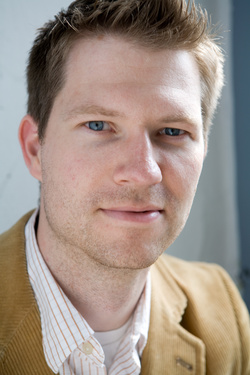
When did you decide that you wanted to do something with music?
Toward the end of my mission, I was in Leipzig and I was trying to determine what I would like to do for my career. I had thought about composing. I went to see a concert and the conductor stood up and conducted Beethoven’s Ninth Symphony without a score in front of him. It was pretty cool, visually.
The beginning of Beethoven’s Ninth is very powerful. The conductor just did this huge swing of the baton—whoosh—and a lot of the performers struck at once. It was a very powerful moment.
I was thinking: Do I want to be a conductor? Do I want to be that person? Or do I want to be the one playing one of these instruments in the ensemble? Or do I want to be writing the music?
That moment influenced my decision, but that evening there were more things going on. There was an atheist family I had taught who had never really been on board and believed that there was a God, and they were at the concert. I was up in the nosebleed section, but I could see them in the hall seated down below. It struck me that these people were able to take in this symphony and be open to its message.
Beethoven’s Ninth Symphony is a poem, “Ode to Joy” by Friedrich Schiller, set to music. My understanding is that the poem was written in response to the Napoleonic wars that were going on.
The poem says, first and foremost, do you believe there is a God? And if you do, then that would mean that we’re all brothers and sisters; we’re all from the same Father. And if that’s the case, then we shouldn’t be killing each other; we are brothers and sisters.
And that was the reason for celebration with the “Ode to Joy.” It was very difficult to get that message across as a missionary knocking on doors, but as a composer, especially in this classical context, you get an audience who is seated there, and they’re just trying to take it in and understand what’s going on—they’re much more of a captive audience. That’s far more persuasive, I felt, at least for this couple. The audience is traveling a few hours to get to this concert and they’re paying good money for it.
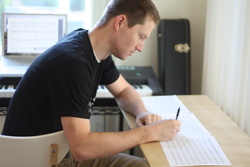
And I thought, That’s another venue. Music has a way of carrying messages. That had an impact on me. I thought, Maybe this is something I want to do.
Initially it was for missionary purposes; I thought that composing was going to be a way that could help to be a conversion tool for truth. Since then, it’s gone through all sorts of twists and turns.
What is your process and how do you go about composing?
My favorite process that I have used was working in collaboration with Marin Leggat on Sydney Ann’s Apple. Marin had approached me about doing this piece, and it was going to be a large-scale piece, so I knew I’d have to pace myself.
During the time leading up to the production, I spent an hour every morning—I just blocked out 7 a.m. to 8 a.m.—and I worked on stuff.
For this piece, I didn’t write any notes down. I didn’t write anything down. They needed a recording, so I composed it all using Logic. I would just play stuff and record myself playing it, and then I would tweak it and edit it. From there it just became a lot of cutting and pasting.
What are the similarities between storytelling and music? How does music tell a story?
First of all, I have to say that sometimes the music that I’m writing deliberately doesn’t tell a story. It may be about a certain concept that I find interesting. I’ve written a piece that is not really about much except for the interaction of certain elements.
But with Sydney Ann’s Apple, it was definitely a story. Marin gave me some very specific things that she was looking for. In the fifth movement of that piece, she was interested in the idea of multiplicity of creation and things being able to continue on for cycles. In the larger aspect, she was thinking about femininity and the role of women, and how that works within the gospel. I think she wanted to explore the idea starting off; her dancers would be one and one, then suddenly those break off into twos, and then those would break into more. And so for me, the whole idea of that one was to try to make a story of how you can split off, continuously.
Once you’ve started something and it starts to take on its own life, you have to give it its due. With Sydney Ann’s Apple, what I was trying to do was start off with that idea of multiplication. It starts off with two different pianos. At the very beginning they split up with something like fractions of segments, which then turn into two different parts.
From there, I wanted to start having multiple voices going on simultaneously, and so there was a point where, in terms of the harmony, that was a secondary idea. I had to use harmonics to create a sense of direction, but the real concern was how I could get four different things going on at once.
You start to imagine the charts of the piece as a container, and you try to fit things around so that one voice is able to be prominent, and then it dies away and another voice emerges, within this container. That’s a basic challenge of what we call “counterpoint” in music; it’s the art of allowing multiple voices to coexist but also maintain a sense of independence from one to the other. For Sydney Ann’s Apple, it started out as two voices, and then I wanted to get to four. It was hard to actually get it to more than that, but I tried to do it by either changing the theme or coming back.
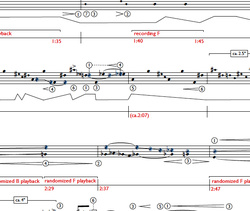
What are some personal projects that have really meant a lot to you?
The piece that I’ve felt was me putting myself out there the most and me challenging myself the most (and also a success in terms of where I felt I was in my level of writing to where I was afterward) was When Spoken to in Dreams.
I have a problem in my writing of not being able to begin a piece, plan it out, and then edit it retroactively—I would always write at the very beginning and just keep on going, pushing through it. I didn’t have the ability to think about whether I had written something that should actually be in the middle of the piece rather than something earlier that hadn’t been written yet. I had a teacher who noticed I had a problem writing large pieces, and he challenged me.
So this was my attempt to write a large piece. I began by saying I wanted to write about a ten-minute piece, to start. I had to plan it starting from the top down.
I decided to use the golden mean—the most basic formal trick that a lot of people had used—and I decided I would have my climax be about two thirds from the middle of the piece.
From there, I started to think about the idea of a Fibonacci sequence. I started to divide the piece into sections, and I tried to figure out if I was going to divide it into seconds or tenths of seconds, or what would compute out to around ten minutes. Ten minutes equals six hundred seconds, so I tried to figure out a Fibonacci number that was close to that. Then I started just dividing and compartmentalizing before I had written anything: I want something cool to happen here. I really want this to happen. And then I started to place sound events together.
That was a big deal for me, because I hadn’t really done that before. In this piece I had created really complicated action, where I had to essentially create a timeline of cues that needed to execute certain things.
It was a big, involved process, and I really enjoyed its challenge from the compositional side.
It all seeds from the Fibonacci sequence, but for the visual component, I had fallen in love with a device that was used in a film called Dreams by Akira Kurosawa. I became interested in his directing and read that he treated sound and visuals like counterpoint. That caught my eye, because I’m familiar with that term.
A lot of composers and filmmakers in a big moment will have a lot of stuff visually and sonically happening—a big scene needs all these things. But Kurosawa would actually look to have music do something big in a place where visually not a whole lot was going on, and vice versa.
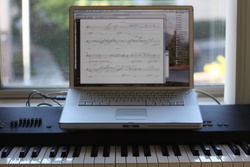
And so I wanted to create this moment where the climax visually was going to be at this golden mean. Sonically, there was a switch. It gets really loud and involved musically leading up to that point, but then it cuts out and becomes far more sparse at that climax, whereas visually it becomes more intense. For me that was really fun to try, and I felt like it was effective.
As I was developing this, I started to think about how this style can be sort of analogous to my own process of trying to receive revelation. And that’s where inserting the title When Spoken to in Dreams comes from. I’m sure all of us as LDS artists, or just as people who are trying to find God, have given a lot of thought to the fact that sometimes you put forth a lot of effort to find God and to know what you’re supposed to do if you’re searching for guidance.
As this piece was progressing, I imagined that the cello, which was part of this piece, was like us. You try harder and harder to find out what’s going on, and then there’s this moment, after all that effort, where God does speak, and you can be quiet enough to hear.
Sometimes that effort and His response don’t seem to have any correlation other than that they didn’t happen at the same time. I think that’s how God talks to me; it’s in a way that’s quiet. Sometimes I really don’t even want an answer and other times I do want an answer but it seems like a long time before I get it. I think that’s how God works. Sometimes He can hit you over the head with something, but it will probably not be in a way that you could expect and anticipate and plan on.
For me, composing that was a success, because I had been urged to be a little forthright from my teachers, and if I had something religious to say then just to say it, and make my piece be about that. This piece really did become about that, and I didn’t back away from that. I didn’t back away from it in the program notes, either.
I think it’s a lot easier to have a message that’s hidden from the audience that only you know, because if it’s something precious to you, then you have the luxury of not having to confront anyone.
But it doesn’t really do anyone a service if you hide what it is that’s on your mind and what your music is about. It doesn’t do you any good, because you’ve written this thing that no one’s ever going to get.
I think that’s one thing that I’m even still trying to develop; music is used as a medium to carry a message, and I think as artists we have a certain responsibility to learn how to convey that message effectively.
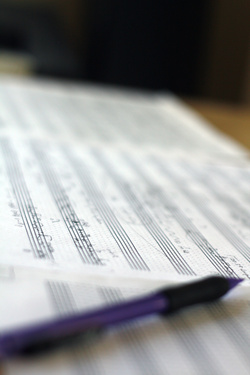
What are you working on right now that you’re really excited about?
I’m working on a piece called The Iron Rod for the trombone and also using electronics. One thing that the trombone can do really well—at least an advanced trombone player—is play multiple notes simultaneously.
If you sing into the trombone while also playing a note, then it will yield what are called multiphonics. And it’s a cool effect. If you are humming the same pitch and playing the same pitch, and then you start to hum out of tune with it, you can create some really dissonant sounds.
I’m really excited about this piece. I also am excited from the standpoint of electronics. My programming will not use any prerecorded material and it will only record him as he’s playing and then reinsert itself later on.
And that’s how you can then expand on this idea, the trombone playing multiple notes simultaneously. If I’m recording it and playing back something that he’s already played, then that allows me to have just one line going out while another line can be going on. You’ve created a counterpoint or chords or harmonies, whatever you want.
How does the gospel affect you as an artist?
I think the gospel affects me as an artist in that, for most everything that I’m writing, I try to couple it with some sort of gospel-related thing, because that’s what my life is—it’s hard to separate the gospel and my beliefs from my basic mode of operating.
And so my pursuit of creating art that is close to who I am tends to also be creating art that is close to the gospel, because I’m a believer.
The gospel has made me a better person, and I naturally want my music, as a sort of tool to spread the news, to reflect that benefit in my life.
Also, I’m going to be creating art that’s authentic. I find myself wanting to be really true to who I am as a person—what I believe in, and what I think. That could refer to my own personality traits, not necessarily just gospel things. I also find that I want the things that I care about to somehow be fused into what’s coming out of me musically.
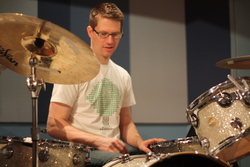
How do you see your work building the kingdom?
I don’t tend to have the opportunity to speak to the masses, and so I find that more and more, communicating the gospel, or building the kingdom, tends to be a fairly small, person-to-person endeavor.
For me, building the kingdom would mean creating a work of art that can be discussed if people choose to talk about the gospel.
In this piece that I have called The Iron Rod, I’ve referred to the Book of Mormon in my program notes. But I’m not trying to beat people over the head. I want to create an invitation for discussion if people are interested.
I think that we as Mormons run into the issue of “we’ve got this burden and task of building the kingdom of God and we’re supposed to spread the gospel to others.” Yet at the same time, any missionary knows that there are people who are not interested. And so there’s this conflict of wanting to really preach the gospel to every creature regardless of what people are going say versus respecting people’s agency and also not isolating yourself.
I think that one of the great things about art is that each of us comes with our own perspective and we’re all made a bit better for it—for being able to have that exposure and have the dialogue about it and enjoy how that dialogue comes from different vantage points. ❧
